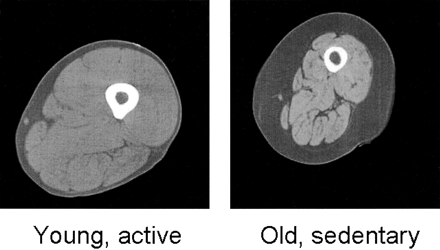- Serving The Woodlands, TX
- 281-825-8674
- Law2@daniell-law.net
REGULAR EXERCISE AND OUR MUTUAL WELL BEING

Three documents your 18 year-old needs to sign before going off to college!
2018-05-02
Those We Leave Behind
2018-10-24(Image: to explain sarcopenia, scientists often use metaphors… As we age, what happens in our bodies is much like the transition – in the beef industry – from free range to USDA prime. See academic source here )
Even if you regularly run, walk, play tennis or ride a bike you may not prevent an incremental loss of muscle mass and strength, even in the muscles you use regularly. Strengthening all your skeletal muscles may just keep you from landing in the emergency room or nursing home after a fall.
Sarcopenia – a decline in skeletal muscle with age, can begin as early as age 40 and, without intervention, can get increasingly worse, with as much as half of muscle mass lost by age 70, and even worse, it’s replaced by fat and fibrous tissue, making muscles resemble a well-marbled steak.
“Sarcopenia can be considered for muscle what osteoporosis is to bone, is one of the most important causes of functional decline and loss of independence in older adults and can seriously impair their physical and emotional well-being and ability to carry out the tasks of daily life” says Saint Louis University School of Medicine. Up to 13 percent of people in their 60s and as many as half of those in their 80s have sarcopenia.
Sarcopenia is also associated with a number of chronic diseases, including insulin resistance, fatigue and falls. Contributing factors include hormonal changes, chronic illness, body-wide inflammation and poor nutrition.
However, no matter how old or out of shape you are, you can restore much of the strength you already lost. Sedentary men aged 60 to 72 significantly increased their leg strength and muscle mass with a 12-week high-intensity resistance strength-training three times a week. Proper technique is critical to getting the desired results without incurring an injury. It’s very important to start at the appropriate level of resistance.
If you’re currently sedentary or have a serious chronic illness, check first with your doctor. But as soon as you get the go-ahead, start a strength-training program preferably after taking a few lessons from a physical therapist or certified trainer.
So, what are you waiting for? Let’s all commit to doing a little each day.
Note: Note: this post I was inspired by a recent article (9/3/2018) at the NYT entitled “Preventing Muscle Loss as We Age” by Jane E. Brody. The article can be assessed here.


